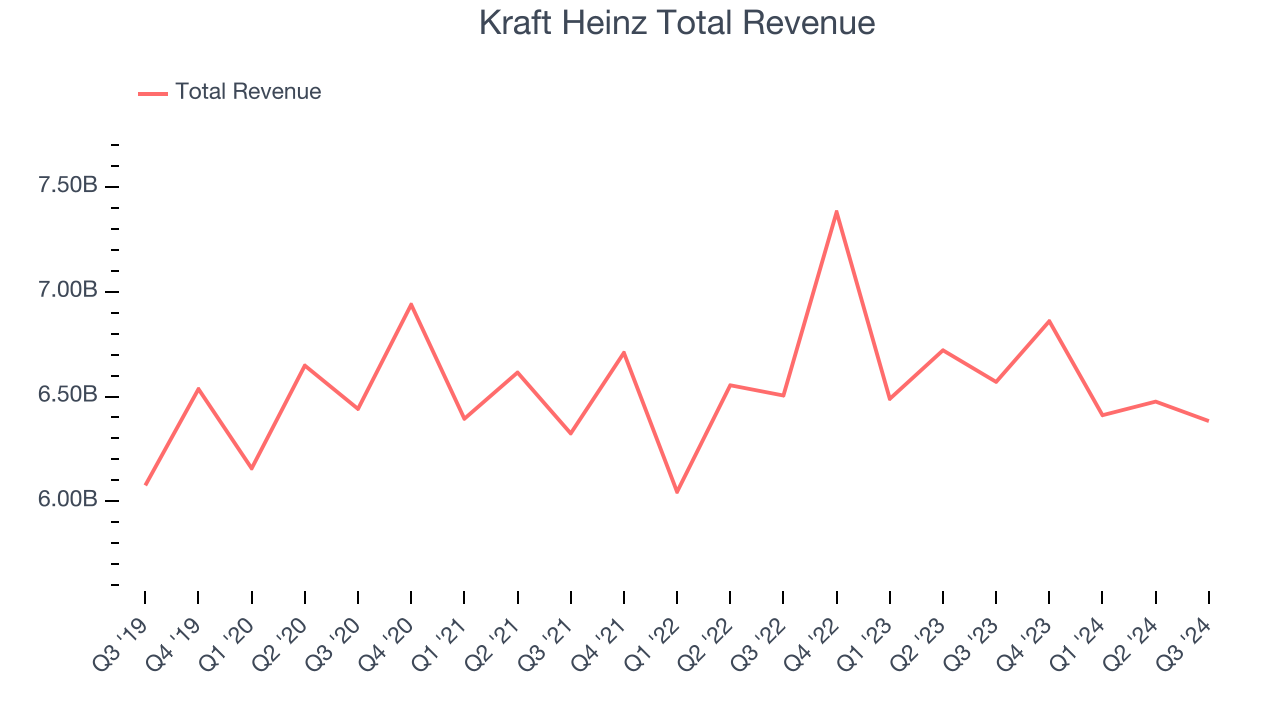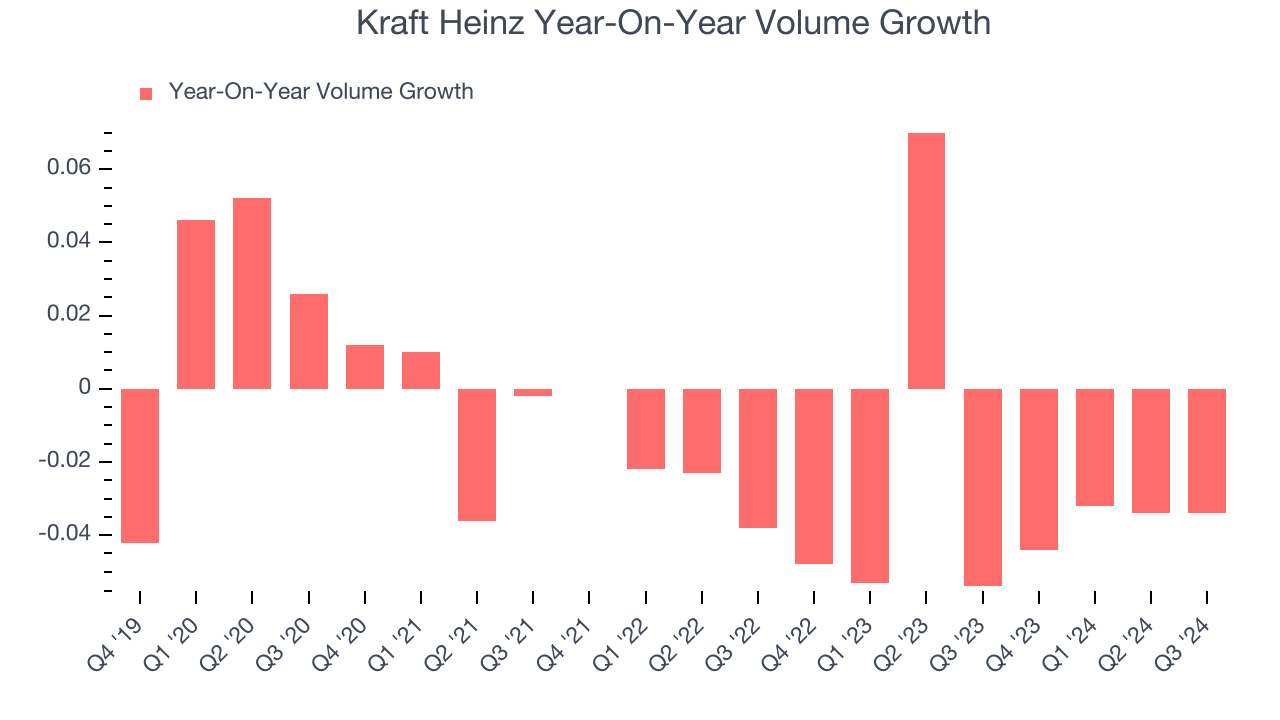
Packaged foods company Kraft Heinz (NASDAQ: KHC) met Wall Street’s revenue expectations in Q3 CY2024, but sales fell 2.8% year on year to $6.38 billion. Its non-GAAP profit of $0.75 per share was 1.2% above analysts’ consensus estimates.
Is now the time to buy Kraft Heinz? Find out by accessing our full research report, it’s free.
Kraft Heinz (KHC) Q3 CY2024 Highlights:
- Revenue: $6.38 billion vs analyst estimates of $6.42 billion (in line)
- Adjusted EPS: $0.75 vs analyst estimates of $0.74 (beat by $0.01)
- Management reiterated its full-year Adjusted EPS guidance of $3.04 at the midpoint
- Gross Margin (GAAP): 34.2%, in line with the same quarter last year
- Operating Margin: -1.6%, down from 9.9% in the same quarter last year
- Organic Revenue fell 2.2% year on year (1.7% in the same quarter last year)
- Sales Volumes fell 3.4% year on year (-5.4% in the same quarter last year)
- Market Capitalization: $42.08 billion
“In the third quarter, our top-line performance across two of our strategic pillars, Global Away From Home and Emerging Markets, grew in line with our expectations,” said Kraft Heinz CEO Carlos Abrams-Rivera.
Company Overview
The result of a 2015 mega-merger between Kraft and Heinz, Kraft Heinz (NASDAQ: KHC) is a packaged foods giant whose products span coffee to cheese to packaged meat.
Shelf-Stable Food
As America industrialized and moved away from an agricultural economy, people faced more demands on their time. Packaged foods emerged as a solution offering convenience to the evolving American family, whether it be canned goods or snacks. Today, Americans seek brands that are high in quality, reliable, and reasonably priced. Furthermore, there's a growing emphasis on health-conscious and sustainable food options. Packaged food stocks are considered resilient investments. People always need to eat, so these companies can enjoy consistent demand as long as they stay on top of changing consumer preferences. The industry spans from multinational corporations to smaller specialized firms and is subject to food safety and labeling regulations.
Sales Growth
A company’s long-term performance can indicate its business quality. Any business can put up a good quarter or two, but many enduring ones grow for years.
Kraft Heinz is one of the most widely recognized consumer staples companies. Its influence over consumers gives it negotiating leverage with distributors, enabling it to pick and choose where it sells its products (a luxury many don’t have). However, its scale is a double-edged sword because there are only so many big store chains to sell into, making it harder to find incremental growth.
As you can see below, Kraft Heinz’s sales were flat over the last three years as consumers bought less of its products. We’ll explore what this means in the "Volume Growth" section.

This quarter, Kraft Heinz reported a rather uninspiring 2.8% year-on-year revenue decline to $6.38 billion of revenue, in line with Wall Street’s estimates.
Looking ahead, sell-side analysts expect revenue to remain flat over the next 12 months. While this projection indicates the market believes its newer products will catalyze better performance, it is still below average for the sector.
Here at StockStory, we certainly understand the potential of thematic investing. Diverse winners from Microsoft (MSFT) to Alphabet (GOOG), Coca-Cola (KO) to Monster Beverage (MNST) could all have been identified as promising growth stories with a megatrend driving the growth. So, in that spirit, we’ve identified a relatively under-the-radar profitable growth stock benefitting from the rise of AI, available to you FREE via this link.
Volume Growth
Revenue growth can be broken down into changes in price and volume (the number of units sold). While both are important, volume is the lifeblood of a successful staples business as there’s a ceiling to what consumers will pay for everyday goods; they can always trade down to non-branded products if the branded versions are too expensive.
To analyze whether Kraft Heinz generated its growth from changes in price or volume, we can compare its volume growth to its organic revenue growth, which excludes non-fundamental impacts on company financials like mergers and currency fluctuations.
Over the last two years, Kraft Heinz’s average quarterly sales volumes have shrunk by 2.9%. This decrease isn’t ideal as the quantity demanded for consumer staples products is typically stable. Luckily, Kraft Heinz was able to offset fewer customers purchasing its products by charging higher prices, enabling it to generate 2.5% average organic revenue growth. We hope the company can grow its volumes soon, however, as consistent price increases (on top of inflation) aren’t sustainable over the long term unless the business is really really special.

In Kraft Heinz’s Q3 2024, sales volumes dropped 3.4% year on year. This result was a further deceleration from the 5.4% year-on-year decline it posted 12 months ago, showing the business is struggling to push its products.
Key Takeaways from Kraft Heinz’s Q3 Results
We struggled to find many strong positives in these results. Its organic revenue unfortunately missed analysts’ expectations and its revenue missed Wall Street’s estimates. Volumes were down year on year despite an easy compare where the same quarter last year also saw declines (meaning it should be easy to grow off of that). Overall, this was a weaker quarter. The stock traded down 3.2% to $33.71 immediately following the results.
The latest quarter from Kraft Heinz’s wasn’t that good. One earnings report doesn’t define a company’s quality, though, so let’s explore whether the stock is a buy at the current price.If you’re making that decision, you should consider the bigger picture of valuation, business qualities, as well as the latest earnings. We cover that in our actionable full research report which you can read here, it’s free.





